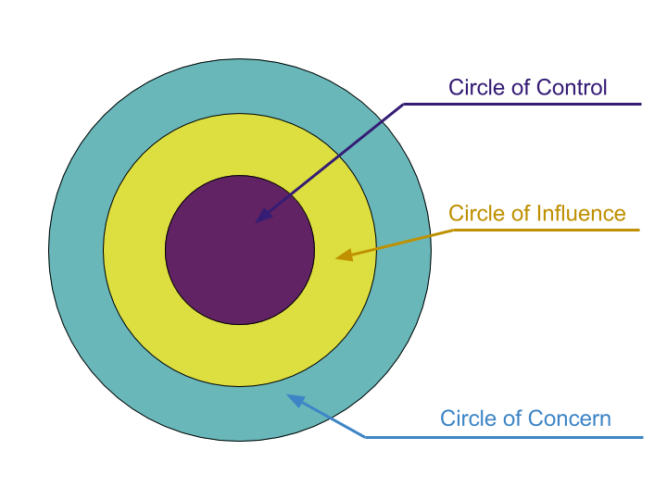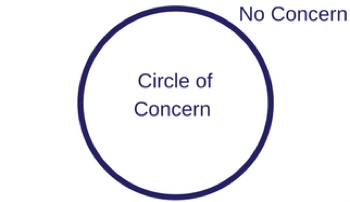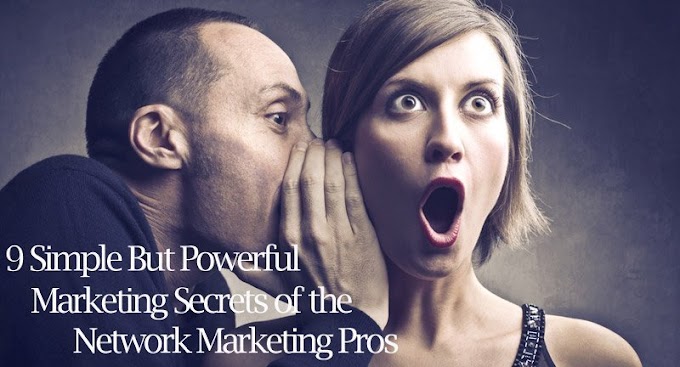Circle of Influence and Control is a tool created by Stephen Covey.
We use it to help you and your team look at all the things that concern you, to help you realise you have more power than you think over things that feel out of your control.
The aim of Circles of Influence and Control and the resulting conversations is to help people take responsibility for their work concerns, and thus be more proactive, productive and happier.
Here’s how to run the exercise – it can be done individually but it’s best with a group:
- On a large sheet of paper, draw a big circle, this is the Circle of Concern.
- Get your team members to write their areas of concern on sticky notes, and put them in the circle. There will be lots of things that are of concern to them or are factors that could be affecting how they feel.
- When they’re done, draw another smaller circle in the middle of the first circle, this is the Circle of Control. These are the things they can control.
- In conversation, move all the sticky notes in the big Circle of Concern that they can actively control, into the middle Circle of Control.

- People usually feel there aren’t many items that they can actively control. They may have a lot of stress and anxiety over the things they’ve written down and will feel they don’t have any control over them. Having no control is alarming.
- So, draw another circle in between the first two – between the circles of Concern and Control. This is the Circle of Influence.
- Get team members to look at the ways they could influence some of the things that are out of their control.
- Maybe they can’t control them, but could they influence them? E.g. could they forge a better relationship with the person outside of the team who’s firing requests at them, and get to the root cause of that?
- Go through all the notes that are in the Circle of Concern and together try to move them into the Circle of Influence.
- When you explore these further, if you think about them differently, you’ll find that some of the concerns can go straight into the Circle of Control.
- You may also discover solutions and suggestions in the group.
Why it’s good
Circles of Influence is a great tool for resilience. If anyone feels out of control, you can question all of the things where they feel that, and see if they can have more agency about them.
For the things they simply can’t control, get them to stop worrying about them. You can’t affect government policy, or the weather… so just put those outside and park it.
At the very least, what is left is awareness of the factors that are outside their circle of influence.
Often it turns out, they realise they can influence more than they think, or they can change their attitude and their response to them. Even the act of acknowledging this creates some relief.
In a team, you’re trying to get to a point of safety where team members feel confident enough to be able to talk about the things they’re frightened of and neutralise those fears.
Doing that as a group means you really get to know each other, building empathy about what concerns you and where your stress comes from. Solving those problems together helps that too.
This is really good for building the rapport of a team: a little bit of vulnerability draws people in.
And it gets away from just focussing on conversations about the mechanics of the work, to acknowledging the emotional response, to the experience of doing the work, to the culture, and how we might be unconsciously creating problems for ourselves and our colleagues.
People are not naturally drawn to these conversations, so we have to find these tools like Circles of Influence to make it easier to talk about this stuff.
Here’s a story to illustrate this
What’s nice about using the Circles of Influence tool is the emotional arc that often accompanies it.
At the beginning, people are often reluctant to participate. So we usually start with people writing on their own.
An awkward bit follows where we try and fit things into the Circle, so we get people standing up around the chart, and have a sort of the cluster.
People often start venting, expressing their anger and their frustration – it can be quite upsetting.
When we get to the bit about the ways we can move things into the Circle of Control, even just having that conversation is empowering for some groups of people.
The emotional arc when someone realises they can influence something they were really worried about and felt they couldn’t control is really heartwarming.
There was a case of someone who was working with a senior exec, she found working with this person incredibly stressful: his personal manner was quite abrupt and accusatory, and he had no idea he was having this impact.
We had to try and make it safe for her to explain, and come up with some approaches for stopping conversations that were not helpful, usually end-of-the-day last minute requests that would need her to stay late.
She had felt completely out of control and unable to engage with the exec, and this thing that she couldn’t control.
In the end, she was able to speak to her manager, who had a side conversation with the exec, and she could begin to deal with some of it. Prior to that, there had been no mechanism for bringing it out.
She was able to move forward and be much happier at work.
What Can I do?
The Circles of Concern and Influence

“God, grant me the serenity to accept the things I cannot change, the courage to change the things I can, and the wisdom to know the difference.”
~ Serenity Prayer
Let’s face it, life can be challenging. We all have things in our life that challenge us – whether it is people, situations or the environment we live in.
This is one of those lessons that is so painfully obvious it’s difficult to understand why anyone would bother to teach it. If we truly can’t change something then why would we ever spend any time on it? And yet, if you’re human like me, you know all too well that we spend a disproportionate amount of time thinking and acting on things that are fundamentally outside of our control. This element of human nature can have distracting and damaging consequences. As human beings, we have the capacity to be proactive. We can focus on the things that we can actually do something about, or we can add to the stress in our lives by worrying and fretting over the things we have no control over.

One thing I have come to realize over the years of working with a great number of people experiencing change, is how differently people either react to change or how they choose to respond to change. Those who effectively embrace change, focus their time and energy on things they actually have control over, instead of wasting their time and energy on things they don’t.
The Circle of Concern vs The Circle of Influence
The “Circle of Concern” includes the wide range of concerns you have in the world, your work and life – including health, family, finances, the economy, national debt etc. Everything you include inside the circle is a concern and matters to you and everything outside the circle is of little or no concern to you.

The challenge with the Circle of Concern is you start to realize that some of the things you find yourself concerned about are outside of your control and some are inside your realm of control.
For example – you may be concerned about the health of a family member or the economy, however can you really do anything about it?
This is why it is important to identify your Circle of Influence within your Circle of Concern.

Your Circle of Influence are the things that concern you that you can do something about. For example – you may be worried about the economy or climate change or coronavirus (i.e. circle of concern), however what can you do about it (i.e. your circle of influence)?
We could rightly say that there’s no point wasting time and energy on the things we can’t control. This is easy in theory but more difficult in practice. Covey’s approach might offer some guidance on how to apply this knowledge in the real World.
We can’t control the economy or a global pandemic. As we react, we tend to focus on the Circle of Concern, which depletes our energy, because we have no control over it. The energy focused on the Circle of Concern is negative. If you focus on the Circle of Concern and neglect the Circle of Influence, eventually the Circle of Influence will get smaller. This will add to feelings of stress and helplessness, because you cannot change anything in the Circle of Concern.
Adding the Circle of Control...
Personally, I believe there are 2 levels of Influence- Direct, the Circle of Control and Indirect, the Circle of Influence, so it just makes it clearer to articulate the power of choice. Subsequently – the diagram would look like this –

Covey would have us focus on what we can impact. He states that a positive and proactive focus on the things we can control will actually have a secondary effect of increasing our Circle of Influence. There is yet another deeper consideration- while there are things we have within our direct control, there are also many things that, while outside of direct control, are however, within our ability to influence (indirect control). By successfully focusing on the things we can influence within our own life, family, or business (e.g. our own actions, behaviors, planning, etc), that impact our own lives directly, we can indirectly have an impact on a larger scale. For example, by focusing on your own business or job, you not only directly affect your own economics, but may begin to have an influence in your local community economy which ultimately contributes on a small scale to a global economic impact or, in the example of climate change, make decisions to recycle that reduce our own direct impact and ultimately indirectly on the larger scale of global climate change. And as we clearly see now, in a global pandemic, our positive personal choices on things within our direct control can have a systemic indirect positive impact on those around us.
In contrast, by spending too much time focused on the things we can’t control in our life, family, or business, we may actually reduce our influence on the things we should be able to control directly. Using the same example above, it’s not difficult to imagine a scenario where an unhealthy concern for what we can’t control leads us to make a reactive decision (e.g. hoarding toilet paper during a pandemic) which then backfires and reduces our ability to maneuver later. This negative focus can create unintended negative outcomes.
Proactive people focus their efforts on their Circles of Influence & Control, which is the area we have control over and we can act upon. They work on the things they can do something about: health, children, business, or work. When you act on your Circle of Influence you are able to reduce stress levels and increase happiness, because you can initiate and influence change.
Reactive people focus their efforts in the Circle of Concern--things over which they have little or no control: the national debt, terrorism, or the weather. Reactive people tend to neglect those issues that are under their control and influence. Their focus is elsewhere and their Circle of Influence shrinks.
“I am not a product of my circumstances. I am a product of my decisions.” -- Dr. Stephen R. Covey
Gaining an awareness of the areas in which we expend our energies is a giant step in becoming proactive.
This concept is easy to remember and is a great tool to direct our energy and actions in meaningful ways on things we do have control over.
Over to You...
So now that you know about the Circles of Concern, Influence and Control, how are you going to apply this knowledge? You might like to invest some time reflecting on the following questions –
1. Where are you currently spending the majority of your focus & time? In the circle of concern or influence?
2. Are you currently being as personally effective as you can in your life?
3. What strategies or tools could you use to help you focus on the things you can control and transform your life?
4. What can you do today to expand your Circle of Influence to build more positive energy in your life and at work?
Feel free to share in the comments below or on our Facebook page, any questions or comments you might have.
Reclaim your courage and confidence. Take the next step towards freedom and opening your heart. Covey’s resource, The 7 Habits of Highly Effective People: Powerful Lessons in Personal Change, is a great place to start.
Reference – Covey, S. (1989). The 7 Habits of Highly Effective People: Powerful Lessons in Personal Change. New York, USA: Simon & Schuster.
Control And Choice
“The chief task in life is simply this: to identify and separate matters so that I can say clearly to myself which are externals not under my control, and which have to do with the choices I actually control. Where do I look for good and evil? Not to uncontrollable externals, but within myself to the choices that are my own…”
(Epictetus, Discourses)
Abraham | Law: Experienced and Exceptional Business & Estate Planning Representation
Michigan Entrepreneurial Business & Estate Planning Attorney Mathew J. Abraham and Abraham | Law have been providing effective legal representation to individuals, families, and businesses for over 26 years. If you have questions about estate planning, starting a new business, or management of an existing business, you should call Abraham | Law at 810.750.0440 or submit an online request to schedule an initial consultation.


























0 Comments
Thank You For Visit And Commenting In This Blog.
Stay Home Stay Safe.
Wish You Wellth.
+918282822858